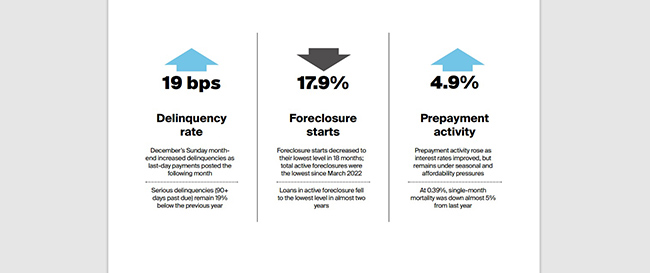
ICE Finds Positive Signs in Housing, Mortgage Markets Ahead of Spring Homebuying Season

(Illustration courtesy of ICE)
Housing affordability has improved in recent months, with the share of income required to purchase the median home falling nearly 5 percentage points from October, and the inventory deficit continues to improve. This indicates a better housing market environment in coming months, according to Intercontinental Exchange.
Mortgage rates equaled 6.71% as of January 24, according to the ICE U.S. Conforming 30-year Fixed Mortgage Rate Lock Index–more than a full percentage point below their October 2023 high. ICE Vice President of Enterprise Research Strategy Andy Walden noted this and other recent market trends have produced positive, yet measured, signs for the 2024 housing market.
“Prospective homebuyers may feel an all-too-familiar sense of dread upon hearing that prices–already at record highs–rose another 5.6% in 2023 according to our ICE Home Price Index,” Walden said. “As always, the truth of the situation is more nuanced than one simple, backward-looking metric might suggest, and the data holds some encouraging signals for these folks. In recent months, we’ve seen improvement in rates, affordability, and for sale inventory, with monthly home price growth moderating on a seasonally adjusted basis. While we are still out of sync with historical norms on multiple fronts, each of those metrics have at least been moving in the right direction.”
Research in February’s ICE Mortgage Monitor Report shows today’s market remains interest-rate-driven. “The recent rebound in affordability has increased purchase mortgage demand, comparable to levels seen last summer when interest rates were in a similar range,” the report said. “Purchase demand continues to trend very consistently with 30-year-rate changes and their downstream impact on affordability.”
Walden said the refinance market has also seen some modest improvement, with the potential for more growth as we move throughout the year. “While the mortgage market remains overwhelmingly purchase-centric, refinance incentive is rising, albeit slowly, alongside easing interest rates,” he said. “Since interest rates peaked back in October, we’ve seen a threefold increase in the number of mortgage holders who could reduce their first lien rate by at least 75 basis points with a rate/term refi.”
While that population stands at roughly 1.7 million–up from 520,000 last fall–it is still a historically small number, Walden continued. If rates should fall to 6% by year end, the number of borrowers with refinance incentive would rise, particularly among 2023-vintage originations, he said.
“Under that scenario–a potential needle-mover for the refinance market–some 46% of 2023-vintage borrowers would be ‘in the money,’ with nearly a third able to cut a full percentage point off their current rates,” Walden said. “As more legacy mortgages regain rate incentive as well, the overall ‘in the money’ population would more than double to 3.8 million by the end of the year, with nearly 60% of that growth coming from loans originated in 2023. Originators would do well to identify and engage with these potential customers now.”
